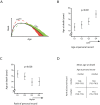Early and extraordinary peaks in physical performance come with a longevity cost
- PMID: 27540872
- PMCID: PMC5032698
- DOI: 10.18632/aging.101023
Early and extraordinary peaks in physical performance come with a longevity cost
Abstract
Life history theory postulates a trade-off between development and maintenance. This trade-off is observed when comparing life histories of different animal species. In humans, however, it is debated if variation in longevity is explained by differences in developmental traits. Observational studies found a trade-off between early and high fecundity and longevity in women. Development encompasses more than fecundity and also concerns growth and physical performance. Here, we show a life history trade-off between early and above average physical performance and longevity in male Olympic athletes. Athletes who peaked at an earlier age showed 17-percent increased mortality rates (95% CI 8-26% per SD, p≤0.001) and athletes who ranked higher showed 11-percent increased mortality rates (95% CI 1-22% per SD, p=0.025). Male athletes who had both an early and extraordinary peak performance suffered a 4.7-year longevity cost. (95% CI 2.1-7.5 years, p=0.001). This is the first time a life history trade-off between physical performance and longevity has been found in humans. This finding deepens our understanding of early developmental influences on the variation of longevity in humans.
Keywords: athletes; development; life history theory; longevity; personal record; trade-off.
Conflict of interest statement
The authors declare that they have no competing financial interests.
Figures


Similar articles
-
Longevity for free? Increased reproduction with limited trade-offs in Drosophila melanogaster selected for increased life span.Exp Gerontol. 2013 Mar;48(3):349-57. doi: 10.1016/j.exger.2013.01.008. Epub 2013 Jan 23. Exp Gerontol. 2013. PMID: 23353929
-
Growing more positive with age: The relationship between reproduction and survival in aging flies.Exp Gerontol. 2017 Apr;90:34-42. doi: 10.1016/j.exger.2017.01.016. Epub 2017 Jan 22. Exp Gerontol. 2017. PMID: 28122252
-
Having it all: historical energy intakes do not generate the anticipated trade-offs in fecundity.Proc Biol Sci. 2006 Jun 7;273(1592):1369-74. doi: 10.1098/rspb.2005.3456. Proc Biol Sci. 2006. PMID: 16777725 Free PMC article.
-
Facultative social insects can provide insights into the reversal of the longevity/fecundity trade-off across the eusocial insects.Curr Opin Insect Sci. 2016 Aug;16:95-103. doi: 10.1016/j.cois.2016.06.001. Epub 2016 Jun 16. Curr Opin Insect Sci. 2016. PMID: 27720058 Review.
-
The role of fecundity and reproductive effort in defining life-history strategies of North American freshwater mussels.Biol Rev Camb Philos Soc. 2013 Aug;88(3):745-66. doi: 10.1111/brv.12028. Epub 2013 Feb 28. Biol Rev Camb Philos Soc. 2013. PMID: 23445204 Review.
Cited by
-
Intellectual maturity and longevity: late-blooming composers and writers live longer than child prodigies.Aging (Albany NY). 2017 May 30;9(5):1433-1439. doi: 10.18632/aging.101245. Aging (Albany NY). 2017. PMID: 28562321 Free PMC article.
-
Lisinopril Preserves Physical Resilience and Extends Life Span in a Genotype-Specific Manner in Drosophila melanogaster.J Gerontol A Biol Sci Med Sci. 2019 Nov 13;74(12):1844-1852. doi: 10.1093/gerona/glz152. J Gerontol A Biol Sci Med Sci. 2019. PMID: 31197356 Free PMC article.
References
MeSH terms
LinkOut - more resources
Full Text Sources
Other Literature Sources
Molecular Biology Databases

